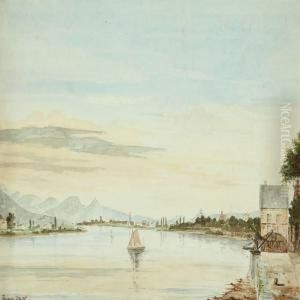Heinrich E Wenck Paintings
Heinrich Emil Charles Wenck was a Danish architect born on March 10, 1851, in Aarhus, Denmark. Wenck's architectural career is closely associated with the Danish State Railways for which he worked for over 40 years, designing numerous railway buildings that have been recognized for their functional and aesthetic qualities.
Wenck studied architecture at the Royal Danish Academy of Fine Arts in Copenhagen, where he was educated under the influence of the Historicist movement, a trend that was predominant in Danish architecture at the time. After completing his studies, Wenck traveled extensively throughout Europe, which was common practice for young architects of his era to gain inspiration and experience.
His professional career took a definitive turn when he was appointed the head architect for the Danish State Railways in 1894, a position he held until his retirement in 1921. During this period, Wenck was responsible for the design of numerous railway stations and related structures across Denmark. His work is characterized by a functional approach and a stylistic versatility that incorporated National Romantic, Neo-Baroque, and Classical elements.
Among his notable works are the Copenhagen Central Station (Københavns Hovedbanegård) and the Elsinore Station (Helsingør Banegård), which reflect his ability to combine practicality with an appealing architectural form. Wenck's contributions to railway architecture extended beyond stations; he also designed a variety of railway-related buildings such as offices, workshops, and housing for railway employees.
Aside from his railway architecture, Wenck was involved in other public and residential projects. Throughout his career, he maintained a commitment to creating designs that were both aesthetically pleasing and functional, a hallmark of Danish architectural practice.
Wenck passed away on February 3, 1936, in Hellerup, Denmark. Today, his legacy is preserved in the many railway stations and buildings he designed, which continue to serve as functional infrastructures and as historical landmarks that reflect the development of Danish architecture at the turn of the 20th century.

